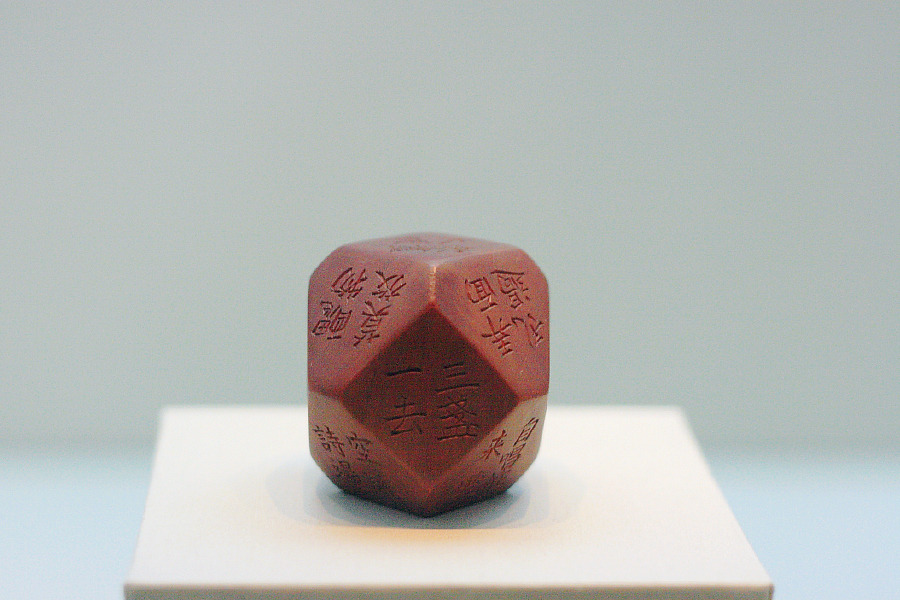
During an archaeological dig in 1975 a 14 sided die was uncovered in a pleasure pond used by royalty of the Unified Silla Period. (about 668 to 935 AD.) The wooden die was unusual in that not only were the sides made up of 6 square and 8 semi-triangular faces, but each face had Chinese characters incised into the surface, which when translated proved to be instructions for a drinking game! (Note that up until fairly recently Hanja, Chinese script, was used in S. Korea as well as Hangul, the Korean alphabet, which was invented in the 15th century, so finding a die with Chinese script does not mean it wasn’t a Korean die.)

The die was found in the city of Gyeongju which is also known as the most historic city in S.Korea due to the extensive number of historical remains. Many think of the city and surrounding area as being the most important cultural site in S. Korea, and it is the 3rd most visited tourist site after Seoul and Busan. Gyeongju was also important in the past and particularly during its’ ‘golden age’ (approx 600-800 AD) and was possibly one of the 5 largest cities in the world at that time. It had extensive trading ties, including to China and Japan, and was known to be a creative and vibrant city, with a wealthy and educated upper class.
And wealthy people often have leisure time which needs to be filled, with games being a perfect way to socialize and pass the time. Each of the sides of the die had penalties or tricks that one was to perform, EumJuGaMu (food,drink,song,dance) was an acceptable way to pass time, and it is supposed that the juryeonggu added a touch more luck and fun to the overall entertainment.
“· Sam-jan-il-geo (三盞一去) : Drinking three glasses of liquor at one time
· Jung-in-ta-bi (衆人打鼻) : Having one’s nose struck by many companions
· Ja-chang-ja-eum (自唱自飮) : Singing and drinking all on one’s own
· Eum-jin-dae-so (飮盡大笑) : Finishing an entire cup and laughing loudly
· Geum-seong-jak-mu (禁聲作舞) : Dancing alone, with no music
· Yu-beom-gong-gwa (有犯空過) : Staying still without flinching, even when being charged at
· Nong-myeon-gong-gwa (弄面孔過) : Staying still without flinching, even when one’s face is tickled
· Gok-bi-jeuk-jin (曲臂則盡) : Finishing an entire cup while interlocking arms with a companion
· Chu-mul-mak-bang (醜物莫放) : Drinking from a cup without removing something dirty from it (presumably placed there by a companion)
· Weol-gyeong-il-gok (月鏡一曲) : Singing the song “Weolgyeong”
· Gong-yeong-si-gwa(空詠詩過) : Reciting a poem
· Im-eui-cheong-ga (任意請歌) : Asking a companion to sing a song of one’s choice
· Ja-chang-Goe-rae-man (自唱怪來晩) : Singing the song “Goeraeman”
· Yang-jan-jeuk-bang (兩盞則放) : When you receive two cups, drain them immediately.”
(The above translation of the instructions are from http://gyeongjulove.blogspot.com/2011/06/casting-14-sided-juryeonggu-anapji.html the web site of the City of Gyeongju.
Other translations/variations appear on the web but these seemed the most easy to understand.
It is not known if this type of die was totally of Silla origin or if it was an improvement and upgrade of Chinese dice, see image above, since 14 and 18 sided dice have been found in China dating back at least 2,000 years with a mix of numbers, blank spaces, or words such as win, and take a drink inscribed on them. Personally I think it likely that the earlier Chinese dice were known, but that someone in Silla took them to to the next level, and created an awesome drinking game.
Korean drama fans may have seen replicas of this die show up in Sageuk such as in episode 6 of
Queen Seondeok, and episode 1, and others, of
Hwarang, The Flower Boys of Silla, but the really sad thing is that the original die they found in 1975 was destroyed while they were trying to preserve it. Only one has ever been found and it no longer exists. Hopefully another die will show up in future excavations, although wood tends only to survive long periods of time in anaerobic (oxygen free) conditions.
Fortunately photographs were taken before the die was destroyed which has enabled replicas to be made. I have heard that you can buy replica dice and even a paper make your own, but I haven’t found a source as yet. I’d love a slightly more modern one, as in written in Hangul, or even a blank one so I could write on it in English. If anyone finds a source for a replica die please let me know.
One of the replica dice is shown above and may be the most accurate as I found a partial description that said it was black lacquer over hardwood oak. This one is now in the National Museum of Korea. One report says it was 5.5 cm x 4 cm but I can’t confirm that anywhere else. I would love to see the original report on the die available in an English translation.
This replica can be seen in the National Gyeongju Museum.
Have a great day everyone.
Photo credits to original owners.
Please do not copy or use without permission and accreditation.






